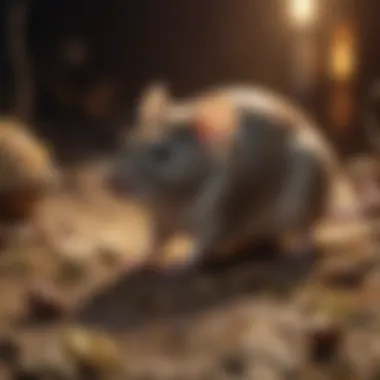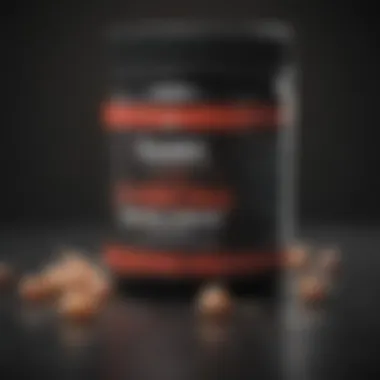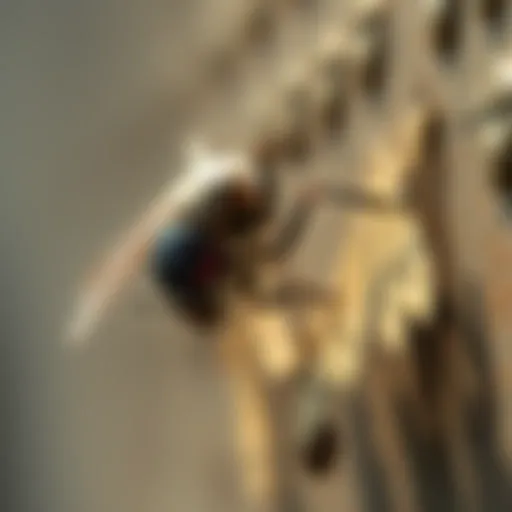Effective Mouse Bait: Selection and Application Guide


Intro
Understanding pest control is essential for maintaining a healthy home. Among all household pests, mice are particularly notorious for their ability to infiltrate living spaces unnoticed. They pose health risks and cause significant structural damage. Therefore, knowing how to identify these unwelcome guests is the first step towards effective management.
This article aims to provide a thorough examination of mouse bait, including selection criteria, effectiveness, safety concerns, and practical application methods. By examining common pests, preventative strategies, and both chemical and natural solutions, readers can develop a deep understanding of how to tackle infestations responsibly and effectively.
Pest Identification
To successfully manage mouse populations, it is crucial to identify the pests present in your home. Mice are small rodents with sharp incisors that allow them to gnaw on various materials. Their presence can often go unnoticed until the damage is evident.
Common Household Pests
Mice belong to the family of rodents, which includes other pests such as rats and squirrels. In residential areas, house mice and deer mice are the most common species.
- House mice are typically gray or brown and have a slender body. They thrive in urban settings, seeking shelter in attics, basements, and behind appliances.
- Deer mice are more common in rural areas and can be distinguished by their white underbellies and bi-colored tails.
Signs of Infestation
Recognizing signs of a mouse infestation is critical for timely action:
- Droppings: Mice leave behind droppings that resemble small black grains of rice, often found along their pathways.
- Gnawed Materials: Chewed furniture, electrical wires, and food packaging indicate active feeding and nesting behaviors.
- Sounds: Scratching noises at night may suggest mice are scurrying within walls or ceilings.
- Nests: Mice build nests using soft materials like paper, fabric, and insulation, typically located in hidden areas.
Mice are nocturnal and tend to remain active when human activity is low, making detection challenging.
Prevention Methods
Preventing mouse infestations is often more effective than tackling them after they occur. Implementing environmental modifications and maintaining home integrity can greatly reduce risks.
Environmental Modifications
Creating a less welcoming environment for mice involves:
- Eliminate Food Sources: Store food in airtight containers and promptly clean any spills or crumbs.
- Seal Entry Points: Inspect for gaps and cracks in walls, foundations, and around windows or doors. Use materials like steel wool or caulk to close these openings.
- Keep Areas Clean: Regularly clean hidden spaces in kitchens, garages, and basements.
Home Maintenance Tips
Additionally, structural upkeep can help deter mice:
- Trim Overhanging Branches: Mice can use tree branches as bridges into your home.
- Limit Outdoor Clutter: Piles of debris or clutter provide excellent nesting opportunities.
- Ensure Proper Drainage: Standing water or wet areas around the home can attract mice.
DIY Pest Control Solutions
For those looking for cost-effective pest control methods, do-it-yourself solutions can be effective if executed correctly.
Natural Remedies
Some homeowners prefer eco-friendly options:
- Peppermint Oil: Strong scents like peppermint are known to repel mice. Placing cotton balls soaked in peppermint oil around entry points can act as a deterrent.
- Vinegar Traps: Mice are drawn to the smell of vinegar. Mixing vinegar with water and setting shallow bowls can help capture curious rodents.
DIY Traps and Barriers
Creating simple trap systems can help manage populations:
- Bucket Trap: Fill a bucket halfway with water, place a ramp leading up to it, and bait the inside with food. Mice will fall in and drown.
- Snap Traps: These traps are effective for quick kills. Position them along walls and behind appliances for the best chance of catching mice.
Mice can be persistent, so combining prevention and control strategies increases your chances of success. By understanding mouse behavior and implementing effective solutions, homeowners can protect their living spaces against these unwelcome pests.
Prelims to Mouse Infestations
Mouse infestations represent a significant challenge for many homes and businesses. Understanding the dynamics of these infestations is crucial for effectively deploying mouse bait and managing the problem. One of the essential aspects of handling mouse infestations lies in recognizing how mice behave, their preferences, and the signs they leave behind. This knowledge not only enables individuals to identify an issue promptly but also helps in choosing the right bait and application strategy.
Prompt identification of mouse activity can lead to early intervention, which is paramount to control the population and minimize damage. Mice are not just nuisances; they pose health risks and can damage property. Their presence can compromise the integrity of structures, as they often chew through insulation, wiring, and even wood. In this article, we will explore these facets comprehensively, highlighting the importance of understanding mouse behavior and infestation signs.


Understanding Mouse Behavior
Mice are agile creatures, known for their ability to enter homes through tiny openings. Their behaviors are instinctual and primarily driven by the search for food and shelter. Mice tend to be nocturnal, which means they are most active during the night, making it easy for them to go unnoticed. They are social animals, often living in groups, which can lead to rapid population growth when conditions are favorable.
Recognizing and understanding their breeding cycles is essential. Female mice can breed as early as six weeks old and can give birth to several litters in a year. Notably, these litters can contain between five to twelve young, significantly increasing the infestation risk in a matter of months if not controlled.
Signs of Infestation
Recognizing the signs of a mouse infestation early can save homeowners from extensive damage. Common indicators include:
- Droppings: Mouse droppings are small, dark, and cylindrical. Finding droppings in areas like the kitchen or pantry is a red flag.
- Nests: Mice build nests from shredded materials. They often locate their nests in hidden areas.
- Chewing: Look for gnawed materials, such as wires, insulation, or food packaging. This activity often indicates their presence.
- Footprints and Smudges: In dusty areas, you may notice small footprints or greasy smudges along surfaces that mice frequently travel.
"Prompt identification of mouse activity can lead to early intervention, minimizing damage and health risks."
Each of these signs provides critical insights for effective pest control strategies. By understanding mouse behavior and recognizing the signs early, a homeowner can make informed decisions about bait selection and application. This foundation sets the stage for the subsequent sections discussing bait types, application strategies, and safety considerations.
The Science Behind Mouse Bait
Understanding the science behind mouse bait is essential for effective pest control. This section delves into the mechanisms of how various baits operate and the factors that influence their success. A comprehensive knowledge of these elements can significantly enhance your ability to choose the right bait for your specific situation, ultimately leading to a more efficient eradication of mouse infestations.
How Bait Works
Mouse baits function on principles of attraction and lethal action. Attractants such as grains and oils often draw mice to the bait, while active ingredients deliver the fatal effects. Monomolecular compounds like bromadiolone and brodifacoum, commonly found in rodenticides, operate by disrupting the clotting mechanism in the mice, leading to internal bleeding over the span of several days. This delayed action allows mice to consume the bait without immediate suspicion from their peers, which can lead to higher efficacy rates.
Mice possess keen senses of smell and taste. Therefore, the formulation of a bait must consider these sensory inputs. If a mouse sniffs an unusual odor or dislikes the taste, it will refuse to eat the bait, rendering it ineffective. Baits are thus designed to mimic natural food sources, enhancing their likelihood of being consumed.
Factors Affecting Bait Efficacy
Several factors can significantly affect the efficacy of mouse bait. These factors include:
- Bait Quality: The freshness and composition of the bait greatly influence its attractiveness. Lower quality baits may have reduced efficacy.
- Infestation Size: A larger population may lead to competitive feeding behavior. If only a few individuals consume bait, it may not be sufficient to reduce the population.
- Environmental Factors: Conditions such as humidity and temperature can alter bait composition and palatability. High humidity can reduce bait effectiveness by causing it to degrade more quickly.
- Mice Diet Preferences: Different mouse species have different dietary preferences. Understanding which bait attracts a particular species can increase the likelihood of success.
"Effective baiting relies on an understanding of both mouse behavior and the environmental context."
In summary, the science behind mouse bait is not just a simple mechanism of killing pests but involves a complex interplay of behavioral, physiological, and environmental factors. Knowledge of these can help homeowners and pest control professionals make informed choices for effective mouse control.
Types of Mouse Bait
Understanding the types of mouse bait available is crucial for effective pest control. This section provides insights into the various categories of mouse bait, emphasizing the benefits and considerations of each type. Different baits attract and eliminate mice in unique ways, impacting their overall effectiveness in managing infestations.
Chemical Baits
Chemical baits are a common choice for dealing with mouse problems due to their potency and availability. They often contain active ingredients specially formulated to target rodents, providing rapid results when used correctly.
Active Ingredients
The active ingredients in chemical baits typically include anticoagulants, like bromadiolone or brodifacoum. These agents work by disrupting the blood clotting process, resulting in the slow death of mice after ingestion. The primary characteristic of these ingredients is their efficiency; they can kill mice within a few days of consumption.
A significant advantage is their ability to work even with a limited amount of bait, which is practical in various environments. In dense urban areas, for example, space constraints often make it challenging to use larger quantities of bait. However, it is essential to remember that these compounds are designed to be toxic, which raises safety concerns. It is prudent to handle them with care and follow manufacturer instructions closely.
Risks and Safety Precautions
Despite their effectiveness, using chemical baits comes with inherent risks. One critical aspect is the potential danger they pose to humans and pets. Accidental intake can lead to severe health issues. Therefore, it is vital to observe safety precautions. Always store baits in secure areas, out of the reach of children and animals.
Additionally, the environmental impact of chemical baits deserves consideration. Non-target species may be affected if these baits are improperly used, leading to broader ecological concerns. Using bait stations can help mitigate these risks by containing the bait and reducing unintentional exposure.
Natural Baits
Natural baits provide an alternative to chemical options, appealing to homeowners who prefer eco-friendly solutions. They typically consist of food items or ingredients that are non-toxic to humans and pets, making them a safer option.
Common Natural Ingredients
Natural baits often utilize ingredients like peanut butter, oats, and seeds. These items attract mice with their familiar smells and tastes, making them a practical choice for baiting. The main characteristic of these ingredients is their natural appeal; they mimic the food sources that mice typically forage for, increasing the likelihood of attracting them to traps.
Natural ingredients offer a straightforward method of baiting. Their ease of use and availability makes them a popular option among homeowners who may not want to deal with complicated setups. However, while they can be effective, natural baits often do not provide the same rapid results as chemical options.


Advantages and Limitations
The main advantage of using natural baits is safety. They pose minimal risk to children and pets, which is a significant consideration for households. However, the effectiveness of natural ingredients may vary based on the level of infestation and the specific preferences of the mice involved.
Moreover, natural baits generally require more frequent replacement than chemical options. Mice may quickly consume them, leading to higher ongoing costs and effort for users. Striking a balance between effectiveness and safety is key when selecting natural baits.
By understanding the array of options available in mouse bait, along with their specific characteristics, homeowners can make informed decisions for effective rodent management.
Choosing the Right Mouse Bait
Selecting the appropriate mouse bait is critical for effectively managing infestations. The right choice can not only enhance the success of pest control efforts but also reduce unnecessary risks to human health and the environment. Different types of baits serve varied purposes, catering to specific mouse behavior, habits, and infestation levels. An informed selection will consider the type of infestation, the particular characteristics of the bait, and the unique environment in which it will be used.
Assessing the Infestation Type
Before choosing a bait, it is essential to assess the type of mouse infestation. Different species, such as the house mouse or the deer mouse, have distinct characteristics. Knowing whether the infestation is small or large, and how entrenched the mice are, aids in selecting the most effective bait. For instance, a crowded bait station may attract more mice but also leads to competition among them. Thorough inspection can reveal droppings, nests, and food sources, which helps in understanding the severity and specifics of the situation.
Comparing Bait Options
Selecting the bait requires a comparison of available options.
Cost-Effectiveness
Cost-effectiveness is a vital aspect in bait selection. It encompasses the price of the bait relative to its efficiency in reducing mouse populations. Some baits may be more expensive but offer significantly better results, making them more economical in the long run. The balance between whatehr the initial investment is too costly versus the savings achieved by effectively reducing mouse numbers must be carefully evaluated. Cheaper options might seem attractive, but they could lead to higher costs if ineffective. Hence, assessing both monetary cost and efficacy provides a clearer picture for decision-making.
Ease of Use
Ease of use is another critical factor. Some baits come ready-to-use, while others may require preparation or technical knowledge. For homeowners or those without pest control experience, user-friendly options are preferable. This characteristic saves time and reduces the likelihood of mistakes during application. Packaging that clearly explains usage instructions is part of this. However, ease of use should not compromise effectiveness. Choosing a bait that fits well with practical application methods ensures that pest control efforts are not hindered.
"An informed choice in mouse bait not only leads to better pest control but also helps in maintaining a safe home environment."
In summary, an informed strategy for choosing mouse bait involves assessing the infestation type and comparing bait options based on cost-effectiveness and ease of use. These considerations play a substantial role in ensuring that the selected bait serves its purpose while minimizing risks.
Best Practices for Bait Application
Applying mouse bait effectively is critical for managing infestations. Understanding best practices can significantly enhance the efficacy of the bait you choose. Proper application not only targets the rodents directly but also reduces potential risks to humans, pets, and the environment. This section touches on essential elements such as placement strategies and monitoring techniques, which can make a substantial difference in the outcome.
Placement Strategies
High Traffic Areas
Understanding high traffic areas is crucial when applying mouse bait. These zones are where mice frequently traverse, making them prime locations for bait placement. Common high traffic areas include behind appliances, along wall edges, and near food sources. By positioning bait where mice are most likely seen, you can increase the probability of successful capture.
The key characteristic of high traffic areas is their frequency of use by mice. They often establish pathways based on access to food, water, and shelter. This means that placing bait in these areas can yield high levels of engagement and ultimately result in better control of the rodent population.
One unique feature of high traffic areas is the likelihood of capturing multiple mice if bait is placed strategically. However, it is important to monitor these locations regularly, as missed baits could mean ongoing activity and possible bait aversion if mice sense danger.
Deterrent Factors
In contrast, understanding deterrent factors helps in predicting mouse behavior. Deterrents are elements that can discourage mice from approaching bait, either physical or environmental. For example, excessive noise or strong odors might keep mice away, rendering bait ineffective.
These factors are prevalent in many households, especially where human activity is high. Mice are naturally cautious and may avoid areas that are hostile or contain potential threats. Hence, recognizing these deterrents is important to make informed decisions about bait placement and to improve the overall efficacy of your pest control measures.
One notable advantage of considering deterrent factors is enhanced safety. By understanding what can keep mice at bay, you can limit the risk of unintended contact with bait, particularly among pets and children. Although these factors can be beneficial, they also pose challenges as they might require additional efforts to minimize their impact, like creating quieter environments during baiting times.
Bait Monitoring Techniques
Visual Inspections
Regular visual inspections are an essential part of bait application. This technique involves checking bait stations frequently to see if the bait is consumed and whether there are any signs of mouse activity. During these inspections, it's crucial to observe droppings, tracks, and chew marks nearby.
The key characteristic of visual inspections is that they provide immediate feedback on bait success. Homeowners can gauge if the chosen bait is effective or if adjustments are necessary. This allows for more strategic planning in bait placement, enhancing efficiency in pest control efforts.
A unique feature of visual inspections lies in their simplicity. They do not require specialized tools and can be performed by anyone. However, one of the disadvantages is the time commitment involved. Regular checks may be needed to adequately assess the situation, making it a less attractive option for busy individuals or families.


Tracking Consumer Reports
Engaging with consumer reports can add a layer of understanding when applying mouse bait. These reports provide insights into different bait types, effectiveness, and user experiences. By tracking feedback on various products, homeowners can make informed decisions based on the effectiveness noted by others.
The key characteristic of using consumer reports is obtaining real-world evidence of potency and safety. People often share personal success stories or struggles with particular bait, offering valuable lessons.
However, there are some disadvantages. Reports can sometimes be biased based on individual experiences, and what works in one setting might not work in another. Therefore, while tracking consumer reports is a beneficial practice, it must be done in conjunction with personal observation and assessment.
Safety Considerations with Mouse Bait
The subject of safety considerations when using mouse bait is critical, as it impacts not only the intended target (the mice) but also humans, pets, and the environment. Awareness about risks associated with both chemical and natural baits is essential for homeowners and pest control professionals. Understanding these safety measures ensures effective use without unintentionally harming others or causing environmental damage.
Health Risks to Humans and Pets
Mouse bait, particularly chemical ones, can pose serious health risks to both humans and pets. Many of these products contain potent substances that, if ingested or mishandled, can lead to poisoning. Children and pets are especially vulnerable due to their curiosity and tendency to explore their environment.
Some symptoms of exposure may include:
- Nausea
- Vomiting
- Abdominal pain
- Neurological issues (in severe cases)
To mitigate these risks, it's crucial to:
- Store baits securely and out of reach of children and pets.
- Follow label instructions accurately.
- Monitor bait placement closely to ensure safety.
By taking these precautions, you can significantly reduce the likelihood of adverse effects.
Environmental Impact of Baits
The environmental impact of mouse baits must also be taken into account. Many chemical baits contain ingredients that can leach into the soil and water systems, potentially harming local wildlife and plants. The persistence of these chemicals in ecosystems can disrupt food chains and result in unintended consequences for biodiversity.
When discussing the environmental considerations, one must refer to the following factors:
- Bioaccumulation: Chemicals may accumulate in the tissues of non-target animals, leading to toxic effects.
- Disruption of ecosystems: Application can adversely affect local flora and fauna.
- Degradability: Assess whether the bait materials break down into less harmful substances over time.
Homeowners should prioritize baits that are designed to minimize environmental footprints. Many manufacturers offer options that are less harmful to the ecosystem, often highlighting this feature in marketing materials.
"Choosing the right bait is not just about efficacy; it's about choosing the safer option for everything else around you."
By considering the potential health risks and the environmental impacts, individuals can make informed decisions about mouse bait selection and application. Understanding these aspects enhances the effectiveness of pest control while promoting a responsible approach that aligns with broader ecological concerns.
Case Studies in Effective Mouse Bait Use
Understanding the application of mouse bait through case studies provides valuable real-world insights for both homeowners and pest management professionals. These examples illuminate practical approaches to bait selection and application. By analyzing successes and setbacks in various settings, we can highlight key considerations for optimizing bait effectiveness. Case studies facilitate a deeper comprehension of how methods can vary based on environment, infestation level, and bait types used. They underscore the need for careful assessment and thoughtful strategy in pest control endeavors.
Residential Success Stories
In residential settings, mouse infestations can lead to significant distress. Case studies show how homeowners effectively tackled these problems using targeted bait strategies.
- The Use of Gel Bait in Apartments: One notable case involved an apartment complex suffering from a prolonged mouse issue. Addressing the problem, management opted for a specialized gel bait, which they placed in discreet locations throughout common areas. This approach not only minimized visibility but also targeted high-traffic pathways for mice. As a result, reports of rodent sightings decreased dramatically within weeks, demonstrating the gel's effectiveness in a multi-unit dwelling.
- Utilization of Natural Bait in Family Homes: Another success involved a family using natural bait, like peanut butter, to combat an infestation in their single-family home. They discovered that placing this appealing bait in captured devices in entryways led to a rapid reduction in mouse activity. This approach emphasized the simplicity and safety of using natural materials, reinforcing the idea that effective pest control can also align with environmental considerations.
Commercial Applications
In commercial contexts, the stakes of mouse infestations are often higher. Businesses face potential health risks, regulatory issues, and damage to reputation. Through various case studies, we find compelling evidence of effective strategies that have been implemented in this realm.
- Food Processing Facilities: A food manufacturing plant struggled with ongoing rodent problems, leading to compliance violations. They engaged a pest control expert, who recommended a dual approach of chemical baits paired with robust sanitation. After implementing this strategy, inspections showed marked improvement in rodent control, demonstrating that comprehensive planning can yield significant results.
- Retail Environments: A retail store faced repeated mouse incursions that jeopardized their operations. They decided to employ electronic bait stations that offered instant monitoring. This modern tech allowed the management team to track bait consumption and respond promptly when mouse activity increased. This proactive method not only improved their pest control but also provided peace of mind to staff and customers alike.
In summary, the examination of residential and commercial case studies reveals practical and effective applications of mouse bait. Each circumstance illustrates different strategies tailored to the specific challenges presented by varying environments. Learning from these examples empowers others to develop informed bait applications that align with their unique needs.
Epilogue
In summarizing the discussion on mouse bait, the focus is on several crucial elements that will aid both homeowners and pest control professionals in their battle against infestations. First, understanding the selection process is imperative. This demands knowledge about the various types of baits available, their ingredients, and how each type responds to specific mouse behaviors. The proper selection of bait significantly enhances the chances of success in eliminating mice effectively.
Next, we considered application strategies. Correct placement of mouse bait can mean the difference between failure and success. Engaging with high-traffic areas where mice are likely to roam, and leveraging bait monitoring techniques ensures that the strategies used are adapting to real-time situations.
Safety factors are another critical consideration. Knowledge about the potential health risks to humans and pets helps in making informed decisions. Additionally, understanding the environmental impacts of different bait types aids in promoting a responsible approach to pest control.
The case studies provide practical insights, demonstrating how theoretical knowledge translates into effective real-world applications. These examples serve as a guide, showcasing best practices that can be adopted in various settings.
"The best defense against mouse infestations is a knowledgeable and proactive approach to bait selection and application."
Finally, the cultivation of key takeaways allows for sustained success. Homeowners and professionals alike must remain diligent in monitoring and adapting their strategies. Effective mouse bait utilization is not a one-time effort; it requires a consistent and informed approach toward pest management.















